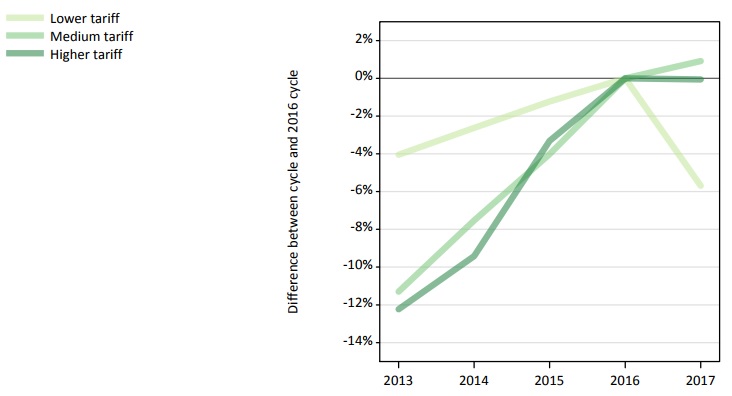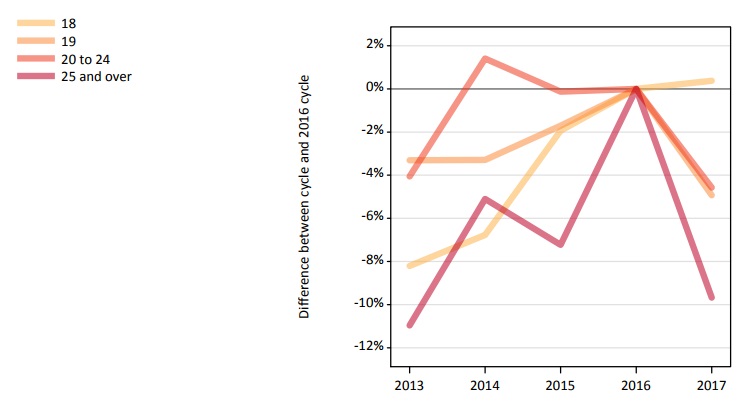Lower-ranked institutions lost out as UK higher education institutions reported a decline in acceptances on A-level results day for the first time since 2012.
A drop in applications from European Union and mature students resulted in 416,310 applicants being placed in universities and colleges as results were released, down 7,570 (1.8 per cent) year-on-year, according to Ucas data.
Lower tariff institutions – those with the lowest entry grades – placed 8,750 fewer applicants, a 5.7 per cent decline. In contrast, middle-ranking universities reported a 0.9 per cent increase, and the performance of the most selective institutions was essentially flat (down 0.1 per cent).
Acceptances by UK universities by tariff group, 2017

Source: Ucas
This suggests a continuation of the trend seen in 2016, when lower-ranked universities were squeezed by prestigious rivals in an environment in which the overall number of applicants is falling and student number controls have been removed. However, the data also appear to indicate that the most selective universities can relax their entry requirements only so far, possibly for fear of adversely affecting their league-table standing.
This year, the proportion of UK school-leavers achieving the top grade at A level reached record levels, with 26.3 per cent of entries getting an A or A*. But the proportion of entries achieving good grades in 13 subjects with new reformed “linear” A levels, being sat for the first time in England, fell compared with last year. At A*, the fall was from 7.7 to 7.2 per cent.
Are you a student? Check out our A-level results day resources
Results day survival blog
A-level results day: going through adjustment
Navigating clearing: what to do if you don’t receive your grades
Clearing 2017: top 10 UK universities with courses available
Access our student pages
Overall, UK higher education institutions accepted 201,270 18-year-olds who live in the UK, slightly higher than in 2016, and the highest ever recorded for any results day.
But universities reported significant falls in acceptances of older students. The number of English over-25s accepted fell by 3,000 (9.7 per cent), with 2,010 20- to 24-year-olds winning places (down 4.6 per cent), and 3,140 fewer 19-year-olds getting in (down 4.9 per cent).
Acceptances by UK universities of English-domiciled applicants, by age

Source: Ucas
And the number of EU students being placed fell by 740 (2.8 per cent).
In contrast, the number of non-EU students counted among the acceptances grew by 1,030 (3.5 per cent).
More than 21,450 of domestic 18-year-olds placed at institutions come from disadvantaged backgrounds, but the most advantaged students are still 2.4 times more likely to be accepted into university.
Alan Palmer, head of policy and research at MillionPlus, which represents modern universities, said the results showed a "worrying downward trend".
"The broader picture for English domiciled students should give us cause for concern," he said.
Clare Marchant, Ucas’ chief executive, described the overall picture as “complicated”.
“We are seeing a growing proportion of 18-year-olds going into higher education, and greater numbers of students from our most deprived communities are securing places,” she said. “At the same time, we are seeing fewer older students taking places, and a fall in numbers from the EU.”




